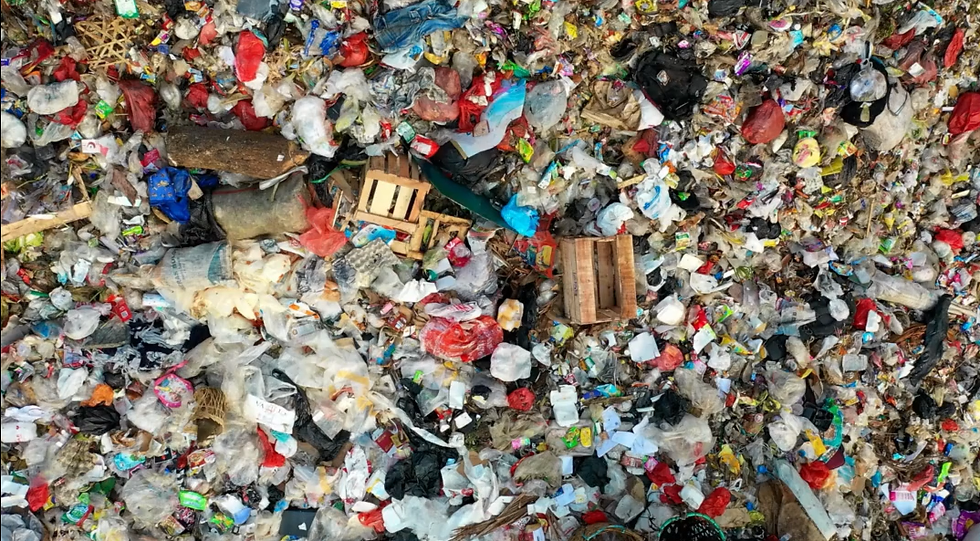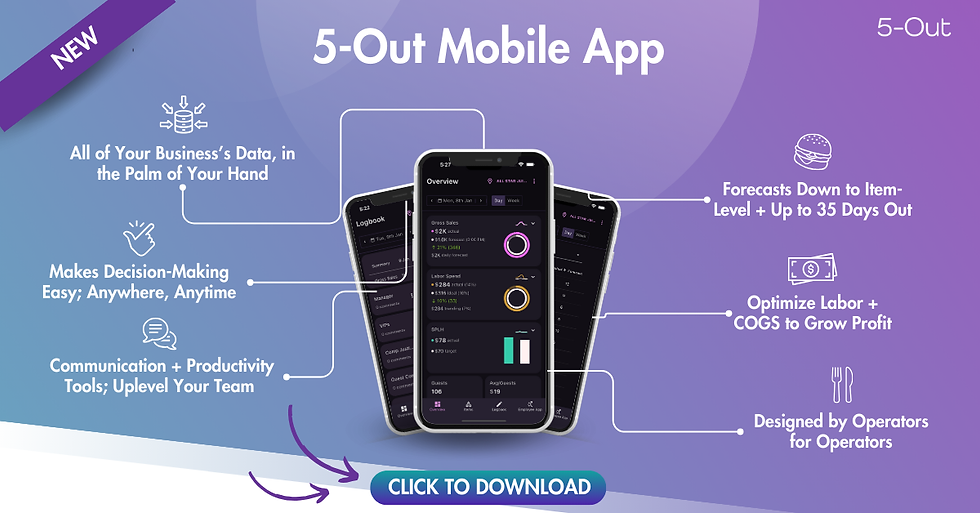Reducing Food Waste in Restaurants: A Sustainable Approach for a Greener Planet
- Erin Watkins

- May 1, 2023
- 11 min read
Updated: Jul 4
Discover how restaurants can reduce food waste and improve sustainability by implementing effective strategies such as menu planning, inventory management, staff training, and customer engagement.
Inventory Management Restaurant Operation

Food waste in restaurants is a significant global issue that affects not only the environment but also the economy and society. The food service industry, in particular, contributes substantially to the problem. Every year in the United States, restaurants waste an estimated 119 billion pounds of food. This is a huge problem for the industry and one that can be reduced significantly.
According to the Food and Agriculture Organization of the United Nations, roughly one-third of all food produced globally is wasted or lost, and a significant portion of this waste occurs in restaurants. Factors such as overproduction, portion sizes, inefficient inventory management, and customer behavior contribute to the generation of restaurant food waste in these establishments.
Therefore, it is essential to raise awareness about the issue of restaurant food waste and to provide practical strategies and solutions for reducing waste. By discussing the causes and consequences of food waste, we aim to encourage the restaurant industry and consumers to take action and contribute to a more sustainable and greener planet.

Importance of Addressing Restaurant Food Waste
Impact on the Environment
Addressing food waste in restaurants is crucial for several reasons. Firstly, restaurant food waste has a significant impact on the environment, as it generates greenhouse gas emissions, mainly in the form of methane, which is released during the decomposition process in landfills. Moreover, the production of excess food consumes valuable resources, such as water, land, and energy. Reducing restaurant food waste can, therefore, help conserve these resources and contribute to a more sustainable food system.
Result in Lost Revenue
Secondly, reducing restaurant food waste is essential from an economic perspective. Food waste in restaurants results in lost revenue and increased food waste disposal costs. By minimizing waste, restaurants can save money and improve their bottom line. Additionally, addressing restaurant food waste can contribute to reducing global food insecurity, as the food saved could be redirected to those in need.

Understanding Food Waste in Restaurants
Causes of Food Waste in Restaurants
1. Overproduction
One of the primary causes of food waste in restaurants is overproduction. Many establishments prepare large quantities of food to ensure they can meet customer demand, offer a wide variety of dishes, and avoid running out of popular menu items. However, this approach often results in surplus food that cannot be sold and ultimately goes to waste. Overproduction can also be a consequence of inaccurate sales forecasting, which makes it difficult for restaurants to plan the amount of food they need to prepare each day.
2. Portion Sizes
Another contributing factor to restaurant food waste is large portion sizes. Many establishments serve generous portions to attract customers and provide value for money. However, these oversized portions can lead to substantial amounts of food being left uneaten on customers' plates and subsequently discarded. Research has shown that reducing portion sizes can significantly decrease food waste without impacting customer satisfaction negatively.
3. Inefficient Inventory Management
Inefficient inventory management can also contribute to food waste in restaurants. Inadequate monitoring and tracking of inventory levels can result in overstocking, which can lead to spoilage and waste. Conversely, understocking can force restaurants to purchase ingredients at the last minute, which may be more expensive and of lower quality, impacting both their bottom line and the environment. Proper inventory management practices, such as regular stock checks and effective storage techniques, can help minimize waste and ensure food safety.
4. Customer Behavior
Lastly, customer behavior plays a significant role in generating food waste in restaurants. Diners can contribute to waste by over-ordering, not finishing their meals, or making specific requests that result in unused ingredients. Additionally, customers may be more likely to waste food when dining out, as they do not bear the direct costs of surplus food. By understanding customer preferences and behavior, restaurants can implement strategies to minimize waste, such as offering customizable menu options and promoting doggy bags for leftovers.
Environmental and Economic Impacts of Food Waste
1. Greenhouse Gas Emissions
Food waste has a significant impact on the environment, primarily through the release of greenhouse gas emissions. When wasted food decomposes in landfills, it generates methane, a potent greenhouse gas that contributes to climate change. According to the Intergovernmental Panel on Climate Change (IPCC), methane is approximately 28 times more potent than carbon dioxide in terms of its global warming potential over a 100-year period. By reducing restaurant food waste, restaurants can help lower their carbon footprint and contribute to mitigating climate change.
2. Waste Disposal Costs
Discarding large quantities of food waste not only harms the environment but also incurs financial costs for restaurants. Waste disposal fees can be significant, especially in areas where landfill space is limited, and disposal costs are high. Implementing restaurant food waste management strategies can help restaurants save money on food scraps and associated costs, such as waste hauling and labor. Moreover, reducing waste can lead to a cleaner and more efficient kitchen environment, further contributing to cost savings and improved employee morale.
3. Lost Revenue
Food waste in restaurants represents lost revenue, as the cost of ingredients, labor, and resources used to produce the wasted food cannot be recovered. By minimizing a great amount of food waste, restaurants can increase their profit margins and make more efficient use of their resources. Reducing waste also offers opportunities to reduce food costs, as purchasing and using ingredients more efficiently can lead to cost savings. In addition, addressing restaurant food waste can enhance a restaurant's reputation and brand image, attracting environmentally conscious customers and potentially leading to increased revenue.

10 Strategies for Reducing Food Waste in Restaurants
Menu Planning and Design
1. Reducing Portion Sizes
One effective strategy for reducing restaurant food waste in restaurants is to reevaluate portion sizes. By offering smaller portions, restaurants can decrease the amount of food left uneaten on customers' plates. Smaller portion options can also be beneficial for health-conscious diners who prefer lighter meals. To ensure customer satisfaction, it is essential to adjust the pricing accordingly and provide clear information on the menu about the sizes offered.
2. Offering Customizable Menu Options
Providing customers with customizable menu options can help minimize food waste by allowing diners to choose the ingredients and portion sizes that suit their preferences and dietary needs. This approach enables restaurants to cater to diverse customer requirements, such as food allergies, dietary restrictions, or specific taste preferences, while reducing the likelihood of uneaten food being returned to the kitchen. Customizable options can include mix-and-match ingredients, build-your-own dishes, or offering a range of side dishes that can be ordered separately.
3. Promoting the Use of Local and Seasonal Ingredients
Incorporating local and seasonal ingredients into the menu can contribute to reducing food waste and promoting sustainability. Sourcing ingredients from nearby producers reduces transportation emissions and supports the local economy. Moreover, seasonal ingredients are often fresher and more flavorful, resulting in higher-quality dishes that are more likely to be enjoyed by customers. By designing menus around local and seasonal ingredients, restaurants can adapt their offerings based on availability and minimize the risk of spoilage and waste. This approach also provides an opportunity to showcase regional flavors and create unique, rotating dishes that keep customers engaged and interested.
Inventory Management and Tracking
1. Implementing a Food Waste Tracking System
Implementing a food waste tracking system is a crucial step in reducing waste in restaurants. This system can help identify patterns and trends in food waste, enabling establishments to address specific areas of concern. A tracking system can be as simple as a manual logbook or as advanced as digital waste tracking software. Regardless of the method used, regularly recording and analyzing food waste data can provide valuable insights into potential improvements in purchasing, preparation, and menu design.
2. Regular Inventory Checks and Proper Storage
Conducting regular inventory checks and ensuring proper storage of ingredients can significantly reduce food waste. Frequent inventory audits can help restaurants identify overstocked or soon-to-expire items and adjust their purchasing accordingly. Proper storage techniques, such as labeling items with dates, maintaining appropriate temperature and humidity levels, and following the first-in, first-out (FIFO) method, can prolong the shelf life of ingredients and minimize spoilage.
3. Utilizing Technology to Optimize Ordering and Food Supply Chain Management
Advancements in technology can greatly assist restaurants in optimizing their ordering and food supply chain management. Inventory management software and mobile apps can streamline the process of tracking inventory levels, monitoring expiration dates, and automating reordering. Integrating these tools with point-of-sale (POS) systems can further enhance their efficiency and accuracy. By leveraging technology, restaurants can better manage their inventory, reduce food waste, and improve their overall operational efficiency.
4. Using Restaurant Sales Forecasting Software to Predict Future Demand
Sales forecasting software, such as the 5-Out sales forecasting tool for restaurants, can be invaluable in predicting future demand and adjusting production levels accordingly. These tools analyze historical sales data and consider factors such as weather, traffic, and holidays, to generate accurate forecasts. By using sales forecasting software, restaurants can better plan their purchasing, staffing, and food production, ultimately reducing waste and improving their bottom line. Accurate sales forecasting also allows establishments to be more responsive to changes in customer preferences and market trends, further enhancing their competitive advantage.
5-Out's AI-driven algorithms and next-generation machine learning capabilities enable it to continuously learn and improve its forecasting accuracy. By analyzing patterns and trends in the data, the software can identify correlations and make predictions with increasing precision over time. This self-improving capability ensures that restaurants can continually refine their waste reduction strategies and respond proactively to changes in customer demand.
5-Out sales forecasting software is designed for easy setup and integration with existing restaurant management systems. This seamless integration allows for a smooth transition, minimizing disruption to daily operations and ensuring that restaurants can start benefiting from the software's insights as quickly as possible. By consolidating data from various sources and providing a centralized platform for analysis, the software simplifies the forecasting process and streamlines decision-making.
Book a demo to manage your inventory to reduce food waste with accurate sales forecasting.
Staff Training and Education
1. Implementing a Food Waste Reduction Culture
To effectively reduce food waste, it is essential to create a food waste prevention culture within the restaurant. Staff training and education play a vital role in fostering this culture. By involving employees in the waste reduction process and emphasizing the importance of sustainability, restaurants can encourage a sense of ownership and responsibility among staff members. Regular team meetings, workshops, and training sessions can be used to discuss food waste issues, share ideas, and set goals for continuous improvement.
2. Teaching Proper Food Handling and Storage Techniques
Educating staff on proper food handling and storage techniques is crucial for minimizing waste and ensuring food safety. Employees should be trained in safe food handling practices, such as proper handwashing, avoiding cross-contamination, and maintaining appropriate temperature control. Additionally, staff should be well-versed in proper storage techniques, such as the first-in, first-out (FIFO) method, and the correct storage conditions for different types of ingredients. By implementing and enforcing these practices, restaurants can reduce food waste, prevent foodborne illnesses, and maintain a high standard of food quality.
3. Encouraging Creative Use of Leftover Ingredients
Another valuable aspect of staff training is encouraging creativity in using leftover food. Chefs and kitchen staff can be trained to develop innovative recipes and dishes that utilize surplus or soon-to-expire ingredients, minimizing waste while providing customers with unique culinary experiences. This approach not only reduces food waste but also helps restaurants differentiate themselves in the market and showcase their commitment to sustainability. Regular brainstorming sessions and collaboration among staff members can foster creativity and inspire inventive solutions to food waste challenges.

Engaging Customers in the Fight Against Food Waste
Transparency and Communication
1. Sharing the Restaurant's Food Waste Reduction Initiatives
Transparency and communication are essential for engaging customers in the fight against food waste. By openly sharing the restaurant's food waste prevention initiatives, customers can better understand the establishment's commitment to sustainability and feel more connected to the cause. This information can be shared through various channels, such as the restaurant's website, social media platforms, in-house signage, or even on the menu itself.
2. Encouraging Customer Feedback and Suggestions
Inviting customers to provide feedback and suggestions on the restaurant's food waste management efforts can help identify areas for improvement and foster a sense of community engagement. Customers often have valuable insights and ideas that can contribute to more effective waste reduction strategies. Feedback can be collected through surveys, comment cards, or social media interactions, and the restaurant can use this input to continuously refine and improve its sustainability initiatives.
Incentives and Promotions
1. Offering Discounts for Bringing Reusable Containers
One way to encourage customers to participate in food waste decline efforts is by offering incentives and promotions. For instance, restaurants can provide discounts to customers who bring their own reusable containers for takeout orders or leftovers. This practice not only reduces waste from disposable packaging but also raises awareness about the importance of sustainability and waste reduction among customers.
2. Rewarding Customers for Choosing Sustainable Menu Options
Restaurants can also reward customers for making sustainable menu choices, such as selecting dishes made with locally sourced ingredients or choosing plant-based options. These rewards can be in the form of loyalty points, discounts, or even small tokens of appreciation. By incentivizing sustainable choices, restaurants can encourage customers to be more conscious of their food decisions and contribute to the overall waste reduction effort.
Collaborating with Local Organizations and Food Rescue Programs
1. Donating Surplus Food to Local Food Banks and Shelters
Collaborating with local organizations and food rescue programs can further amplify a restaurant's food waste decline efforts. It is helpful to donate surplus food to local food banks, shelters, or other charitable organizations to support those in need while reducing waste. Establishing partnerships with these organizations not only benefits the community but also enhances the restaurant's reputation as a responsible and compassionate business.
2. Partnering with Food Waste Reduction Campaigns
Partnering with food waste avoidance campaigns, such as the Zero Waste Movement or the Love Food Hate Waste campaign, can help raise awareness about the issue and mobilize collective action. By joining forces with these campaigns, restaurants can leverage their resources, share best practices, and work together towards a common goal of reducing food waste and promoting sustainability. This collaboration also signals to customers that the restaurant is committed to making a positive impact on the environment and society.

Measuring Success and Continuous Improvement
Establishing Food Waste Reduction Goals and Targets
To effectively reduce food waste and continuously improve waste reduction efforts, it is essential to establish clear goals and targets. These goals should be specific, measurable, achievable, relevant, and time-bound (SMART) to ensure they are both realistic and impactful. Examples of food waste management goals might include reducing waste by a certain percentage within a specified time frame or diverting a specific amount of waste from landfills each month. By setting clear goals and targets, restaurants can better focus their efforts and track food waste over time.
Regularly Monitoring and Evaluating Progress
Monitoring and evaluating progress toward food waste decreases goals is a crucial component of continuous improvement. Regular audits, waste tracking, and performance reviews can help restaurants identify areas of success and opportunities for improvement. By evaluating progress, restaurants can gain insights into the effectiveness of their waste reduction strategies and make data-driven decisions on how to refine their efforts. Sharing progress updates with staff and customers can also help maintain motivation and reduce food waste
Adapting and Refining Strategies as Needed
As restaurants monitor and evaluate their progress, it is essential to adapt and refine their strategies to reduce waste. Continuous improvement involves a willingness to learn from both successes and failures and make adjustments accordingly. This iterative process allows restaurants to optimize their waste reduction efforts, identify new opportunities, and stay abreast of industry trends and best practices. By embracing a mindset of continuous improvement, restaurants can ensure their food waste decrease initiatives remain effective, relevant, and aligned with their overall sustainability goals.

Reducing Food Waste through AI and Next-Gen Machine Learning Software
Food waste is a significant issue facing the restaurant industry, with far-reaching environmental, economic, and social consequences. Implementing effective waste reduction strategies is essential for promoting sustainability and improving operational efficiency. The 5-Out sales forecasting software offers a powerful solution for restaurants, harnessing the power of AI and next-generation machine learning to accurately predict future demand and optimize inventory management, staffing, and food production.
Don't let food waste continue to impact your restaurant's bottom line and sustainability efforts. Request a demo now and take advantage of the 5-Out sales forecasting software to reduce restaurant food waste, enhance your establishment's reputation, and contribute to a greener, more sustainable future.
You may also be interested in:



Comments